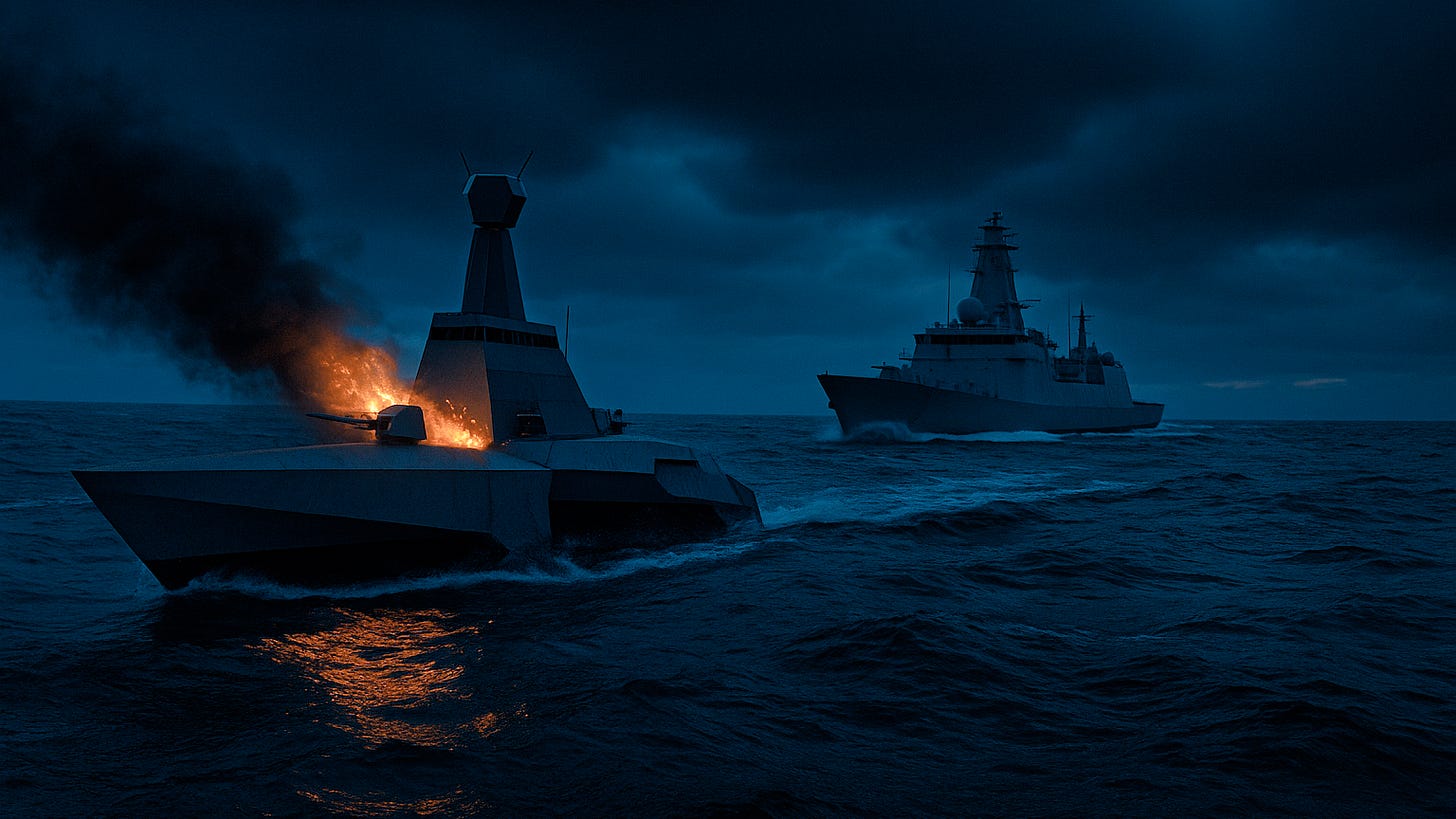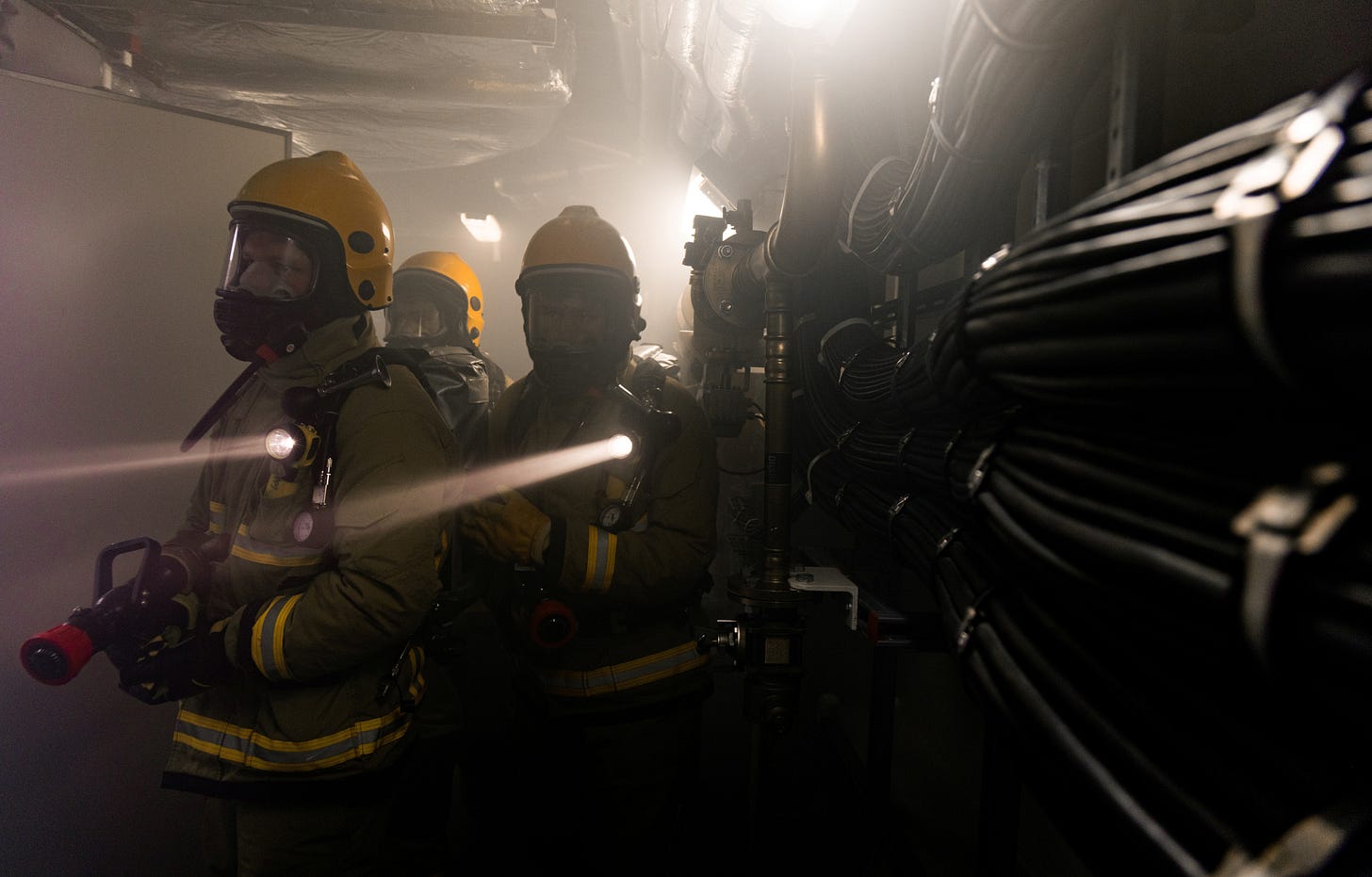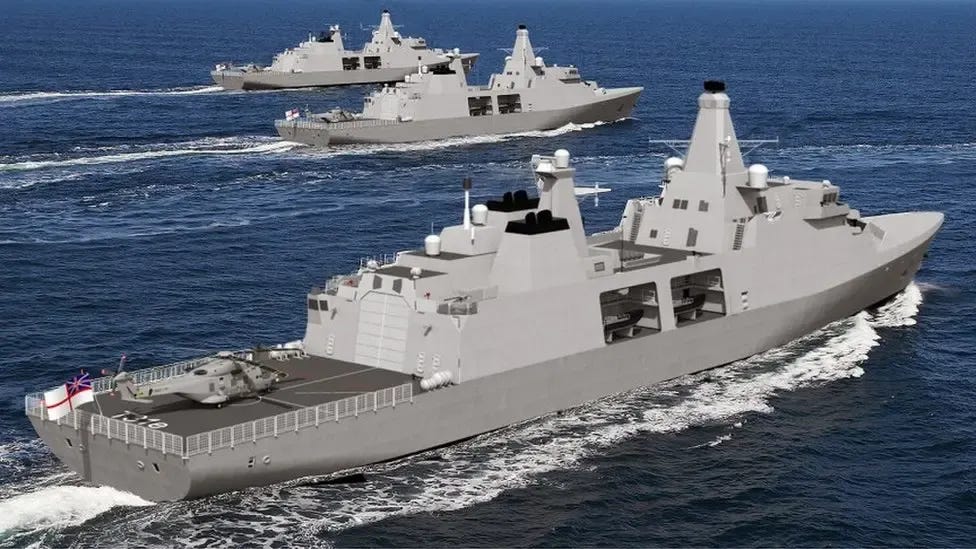The AI Shipmate: Part 2
Survivability, Damage Control, and the Underwater Battlespace
Introduction
If Part 1 of The AI Shipmate was about strategy and design, Part 2 is about the complex realities of fighting and surviving with uncrewed escorts. The First Sea Lord has set a two-year target for uncrewed ships to sail with Type 26 frigates. Still, real progress depends not just on technology, it depends on changing how the Royal Navy thinks about manning, survivability, and the subsea battlespace itself.
Survivability Re-defined: From Saving Ships to Managing Risk
Traditional naval damage control is built on sailors in breathing apparatus, hatches being shut, hoses run out, and compartments being fought over until the fire is out.
On lean-manned or uncrewed escorts, none of that applies.
As discussed at the Naval Damage Control 2025 conference, the issue is cultural as much as technical:
Lean-manned ships rely on automated sensors and SCADA systems to trigger suppression. Senior chiefs often struggle to “unlearn” instincts developed on fully crewed platforms, wanting to verify valves or boundaries by hand even when automation is faster.
Optionally crewed platforms are the worst of both worlds, designed for humans but optimised for autonomy, they inherit complexity without resilience.
Fully uncrewed vessels shift the definition of damage control altogether: sometimes “control” means maximising destruction (self-scuttle, EMP burn-out, or explosive denial) to prevent technology capture, not saving the hull.
In this new era, survivability is not about keeping a ship afloat at all costs, it is about preserving combat power while denying advantage to the enemy.
Type 31: The Live Testbed for Cultural Change
The Type 31 frigate sits at the centre of this shift. Its general arrangement makes it a natural uncrewed integration platform:
119 m² mission bay (6×TEU containers).
Four boat bays for USVs.
Chinook-capable deck and Merlin hangar.
TACTICOS CMS at the heart of its ops room.
Yet the real battle is cultural. At DSEI 2025, several officers admitted that while Type 31’s plant can be run remotely from the bridge (like a commercial ship), navigators still want an engineer “in the space.” The First Sea Lord’s challenge is as much about persuading his leadership team to trust automation as it is about buying new hulls.
Combat Management: Fighting With and Through Escorts
The integration of uncrewed escorts depends on the digital backbone. Thales TACTICOS, fitted in Type 31, is already designed for this:
Open architecture (DDS middleware) enables the rapid integration of autonomous apps.
MOC Mk4 consoles reduce cognitive load with workflow-driven automation.
Embedded training/simulation means crews can train with virtual escorts before real ones arrive.
BAE’s RECODE programme adds another layer, turning the RN’s CMS into an app-based system of systems. This spiral development approach enables the integration of loyal escorts on fast timelines, not the decade-long cycles of past CMS upgrades.
The Underwater Battlespace: The Missing Puzzle Piece
The RN’s escort vision cannot work without subsea integration. The 2025 Strategic Defence Review is explicit: defending the Atlantic Bastion requires layered systems above, on, and below the water.
BAE’s subsea brief highlights the problem: underwater comms remain the missing puzzle piece. Acoustic links are low bandwidth and fragile; optical comms are short range; RF cannot penetrate water. Without reliable subsea networking, escort formations will struggle to fuse data and command effectors at speed.
Industry is responding:
BAE Digital Intelligence has trialled multi-node hybrid subsea networks.
NATO REPMUS is pushing Allied Underwater Battlespace Mission Networks.
AUKUS Innovation Challenge 2025 is focused on near-real-time comms between XLUUVs.
But for now, subsea C2 remains the Achilles’ heel of distributed lethality at sea.
DSEI 2025: Industry Aligns With the Vision
DSEI confirmed that industry is racing to match the RN’s demand signal:
BAE’s trimaran escort concept – lean-manned or autonomous picket with self-defence, sensors, and effectors.
BAE’s Air Warfare Command Ship – a command node for deployed escorts.
BAE Herne XLUUV – autonomous submarine, targeting production by 2027.
Ultra Maritime’s Sea Spear sonar – containerised ASW pods deployable from manned or unmanned platforms.
Thales + HII REMUS – UUVs with synthetic aperture sonar for mine warfare.
This is the industry’s direct answer to the First Sea Lord’s two-year timeline: concepts, prototypes, and modular payloads designed for spiral insertion, not long-cycle procurement.
Conclusion: The Real Challenge is Trust

The RN has the technology: modular frigates, open-architecture CMS, uncrewed prototypes, and industry aligned on two-year horizons. The real barrier is trust.
Trusting sensors instead of instinct.
Trusting automation to fight fires and floods.
Trusting escorts that may not come home.
Trusting subsea networks that are still being built.
The First Sea Lord’s agenda will succeed if the RN’s leadership can accept that survivability is no longer about the ship, it is about the system. However, the AI shipmate is not just another hull; it is a cultural leap. But technology alone cannot deliver advantage. Even if subsea networks close the missing puzzle piece, it is people who must decide when and how to use them.
The next challenge is not hardware, but leadership. How will the Royal Navy’s commanders and warfare teams adapt when the AI Shipmate becomes more than a tool, when it becomes a loyal wingman?
That is the question we take up in Part 3 of the AI Shipmate.
Sources & Further Reading
Combined Naval Event 2025 – RN Transformation & FADS
UK Naval leadership statements on autonomy, mass, and “uncrewed where possible, crewed where needed.”
Combined Naval Event 2025 Insights Report (Navy Leaders)Naval Damage Control 2025 – Lean Manning & Autonomy
Special feature: “Damage Control on Lean-Manned and Autonomous Platforms.” Key insights on sensor trust, cultural friction, and redefining survivability.
Naval Damage Control Feature, 2025 (BAE Systems/industry briefing)Type 31 General Arrangement
Royal Navy design notes: 119m² mission bay (6×TEU), four boat bays, Chinook-capable deck, Merlin hangar, and TACTICOS CMS fit.
Royal Navy Type 31 GA (Navy Lookout coverage)TACTICOS Combat Management System
Thales CMS architecture brief: DDS middleware, app-based integration, and modular workflow.
Thales TACTICOS Combat Management SystemBAE Systems – Exploiting the Underwater Battlespace
Analysis of ISR, ASW, and critical undersea infrastructure protection, with emphasis on next-gen subsea networking.
BAE Systems Digital Intelligence White Paper, July 2025BAE DSEI 2025 Media Brief
“Designing and delivering naval ships of the future” – unveiling Future Air Warfare Command Ship and Deployed Sensor/Effector Platform concepts.
BAE Systems Maritime, DSEI 2025





